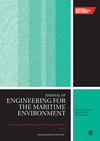Wave energy converter efficiency based on wave transmission and relative capture width performance
IF 1.5
4区 工程技术
Q3 ENGINEERING, MARINE
Proceedings of the Institution of Mechanical Engineers, Part M: Journal of Engineering for the Maritime Environment
Pub Date : 2023-12-29
DOI:10.1177/14750902231217357
引用次数: 0
Abstract
A series of quantitative analyses were performed to identify the wave properties and potential, by means of records collected from an offshore buoy in North-West Ireland. Based on the data collected, a series of quantitative analyses was conducted to determine the dominant wind directions and wave properties on an annual basis. In addition, the wave power is computed based on relevant wave heights and periods, and the Pierson-Moskowitz spectral model was used to generate the maximum wave energy spectra for each year. The results show that waves with wave powers of around 100 kW/m were mostly approaching eastward at a rather narrow frequency. In order to compare the relative capture width and the power absorption capacity of three floating structures, the Wave Dragon, Board Net Breakwater, and Cylindrical Floating Breakwater are analyzed. Also outlined is the impact of the transmission coefficient on the effectiveness of wave energy converters (WEC) throughout the energy harvesting process. This was accomplished by fusing information from three distinct field investigations and experimental research with four different wave transmission coefficient models. The results show that as the wave steepness increases, the transmission coefficient decreases and the hydrodynamic performance of wave energy converters increases. Also, it is found that the hydrodynamic efficiency of wave energy converters is higher in summer than in winter, and the Wave Dragon is the most efficient wave energy converter in regard to relative capture width and power absorption.基于波浪传输和相对捕获宽度性能的波浪能转换器效率
通过从爱尔兰西北部海上浮标收集的记录,进行了一系列定量分析,以确定波浪特性和潜力。根据收集到的数据,进行了一系列定量分析,以确定每年的主导风向和波浪特性。此外,还根据相关的波高和周期计算了波功率,并使用皮尔森-莫斯考维茨频谱模型生成了每年的最大波能量频谱。结果显示,波功率在 100 kW/m 左右的波浪大多以相当窄的频率向东靠近。为了比较三种浮动结构的相对捕获宽度和功率吸收能力,对波浪龙、板网防波堤和圆柱形浮动防波堤进行了分析。此外,还概述了传输系数在整个能量收集过程中对波能转换器(WEC)有效性的影响。这是通过将三项不同的实地调查和实验研究的信息与四种不同的波浪传输系数模型相结合来实现的。结果表明,随着波浪陡度的增加,传输系数降低,波浪能转换器的水动力性能增加。此外,研究还发现,波浪能转换器的水动力效率在夏季高于冬季,就相对捕获宽度和功率吸收而言,"波浪龙 "是效率最高的波浪能转换器。
本文章由计算机程序翻译,如有差异,请以英文原文为准。
求助全文
约1分钟内获得全文
求助全文
来源期刊

CiteScore
3.90
自引率
11.10%
发文量
77
审稿时长
>12 weeks
期刊介绍:
The Journal of Engineering for the Maritime Environment is concerned with the design, production and operation of engineering artefacts for the maritime environment. The journal straddles the traditional boundaries of naval architecture, marine engineering, offshore/ocean engineering, coastal engineering and port engineering.
 求助内容:
求助内容: 应助结果提醒方式:
应助结果提醒方式:


